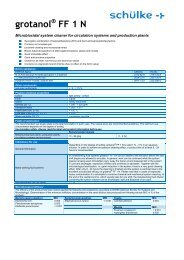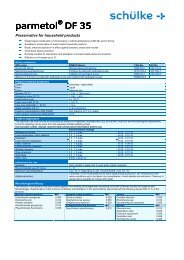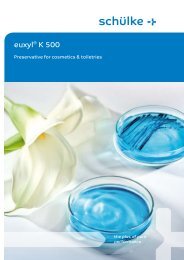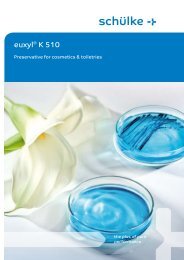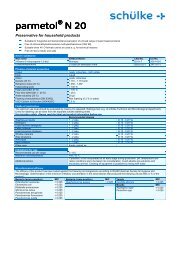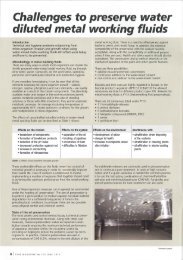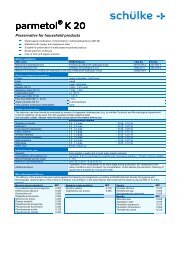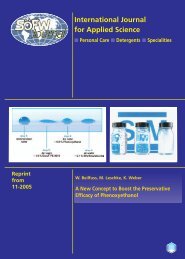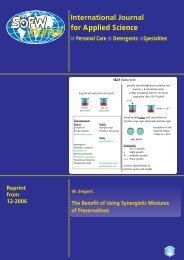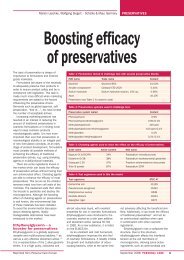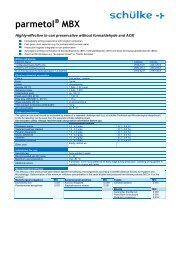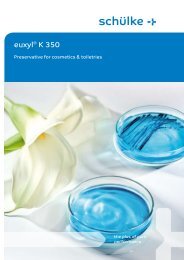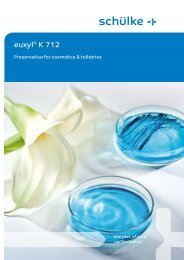ISO 11930 â A Comparison to other Methods to ... - ResearchGate
ISO 11930 â A Comparison to other Methods to ... - ResearchGate
ISO 11930 â A Comparison to other Methods to ... - ResearchGate
You also want an ePaper? Increase the reach of your titles
YUMPU automatically turns print PDFs into web optimized ePapers that Google loves.
COSMETICS<br />
PRESERVATION<br />
• The antimicrobial activity of the preparation<br />
in its final container is investigated<br />
over the period of validity <strong>to</strong><br />
ensure that such activity has not been<br />
impaired by s<strong>to</strong>rage.<br />
USP 35<br />
The USP 35 does not address the issue of<br />
stability; there is only the statement:<br />
• The tests and criteria for effectiveness<br />
apply <strong>to</strong> a product in the original, unopened<br />
container in which it was distributed<br />
by the manufacturer.<br />
ASEAN<br />
There is no hint <strong>to</strong> preservative stability<br />
in the ASEAN test.<br />
CTFA / M-3<br />
Under »Other Considerations« the s<strong>to</strong>rage<br />
stability is included:<br />
Unpreserved lotion -<br />
Preservative System<br />
Lotion preservative 1 1.0 % combination phenoxyethanol / ethylhexylglycerin 1)<br />
Lotion preservative 2 1.1 % combination phenoxyethanol / ethylhexylglycerin 1)<br />
Lotion preservative 3 1.0 % combination phenoxyethanol / ethylhexylglycerin 1)<br />
0.1 % ethylhexylglycerin (preservative booster) 2)<br />
Lotion preservative 4 1.0 % combination phenoxyethanol / ethylhexylglycerin 1)<br />
0.06 % combination ethylhexylglycerin / methylisothiazolinone<br />
3)<br />
Lotion preservative 5 1.0 % combination phenoxyethanol / benzyl alcohol /<br />
potassium sorbate 4) (pH adjusted <strong>to</strong> 5.3)<br />
Lotion preservative 6 1 % combination phenoxyethanol / benzoic acid /<br />
dehydroacetic acid / ethylhexylglycerin / polyaminopropyl<br />
biguanide 5) (pH adjusted <strong>to</strong> 5.1)<br />
1)<br />
euxyl® PE 9010<br />
2)<br />
sensiva® SC 50<br />
3)<br />
euxyl® K 220<br />
4)<br />
euxyl® K 700<br />
5)<br />
euxyl® K 702<br />
Table 12 Selected preservative systems used in the challenge test<br />
• It is important that challenge tests also<br />
be conducted on samples aged in<br />
the final container in order <strong>to</strong> determine<br />
the stability of the preservative<br />
system.<br />
CTFA / M-4<br />
For eye area cosmetic it is clearly stated<br />
in the guidelines:<br />
• Product should be evaluated for<br />
preservative stability in commercial<br />
packaging by testing after s<strong>to</strong>rage<br />
that simulates warehouse, shipping<br />
and shelf-life conditions.<br />
■ Experimental Data<br />
Using a body lotion containing Q10 from<br />
an actual market request, we ran the<br />
preservative efficacy tests according <strong>to</strong><br />
<strong>ISO</strong> <strong>11930</strong> in comparison <strong>to</strong> Ph. Eur. 7 and<br />
the schülke KoKo test. Formulations containing<br />
coenzyme Q-10 (ubichinone) are<br />
known <strong>to</strong> be more susceptible <strong>to</strong> mould<br />
growth. Table 12 shows the preservative<br />
systems that have been selected for the<br />
challenge test.<br />
For the <strong>ISO</strong> <strong>11930</strong> and Ph. Eur. test reduction<br />
in microbial counts are expressed<br />
in log units (R x<br />
=lgN 0<br />
– lgN x<br />
). Negative<br />
figures indicate an increase of the microbial<br />
count in the test sample.<br />
For the KoKo test, the preserving effect<br />
is evaluated semi-quantitatively by the<br />
growth of different streaks. The microbial<br />
growth is classified in bacteria, yeasts<br />
and moulds according <strong>to</strong> the following<br />
legend:<br />
B = Bacteria<br />
M = Moulds<br />
Sp = Sporeforming bacteria<br />
Y = Yeasts<br />
- = free of growth<br />
+ = slight growth<br />
++ = moderate growth<br />
+++= heavy growth<br />
Table 13 Test results unpreserved lotion<br />
Table 14 <strong>to</strong> 19 display the results achieved<br />
with the different preservative systems.<br />
■ Summary Experimental Data<br />
Table 20 summarises the assessment of<br />
the antimicrobial protection with regards<br />
<strong>to</strong> the different test methods.<br />
The criteria of acceptance for <strong>ISO</strong> <strong>11930</strong><br />
appear <strong>to</strong> be the easiest <strong>to</strong> fulfil. It is<br />
questionable if the demands of protection<br />
for a cosmetic product should not<br />
be stricter than for pharmaceutical<br />
products. The test for efficacy of antimicrobial<br />
preservation according <strong>to</strong> EU<br />
Pharmacopoeia and the criteria of acceptance<br />
are designed for the produc-<br />
50 SOFW-Journal | 138 | 7-2012




